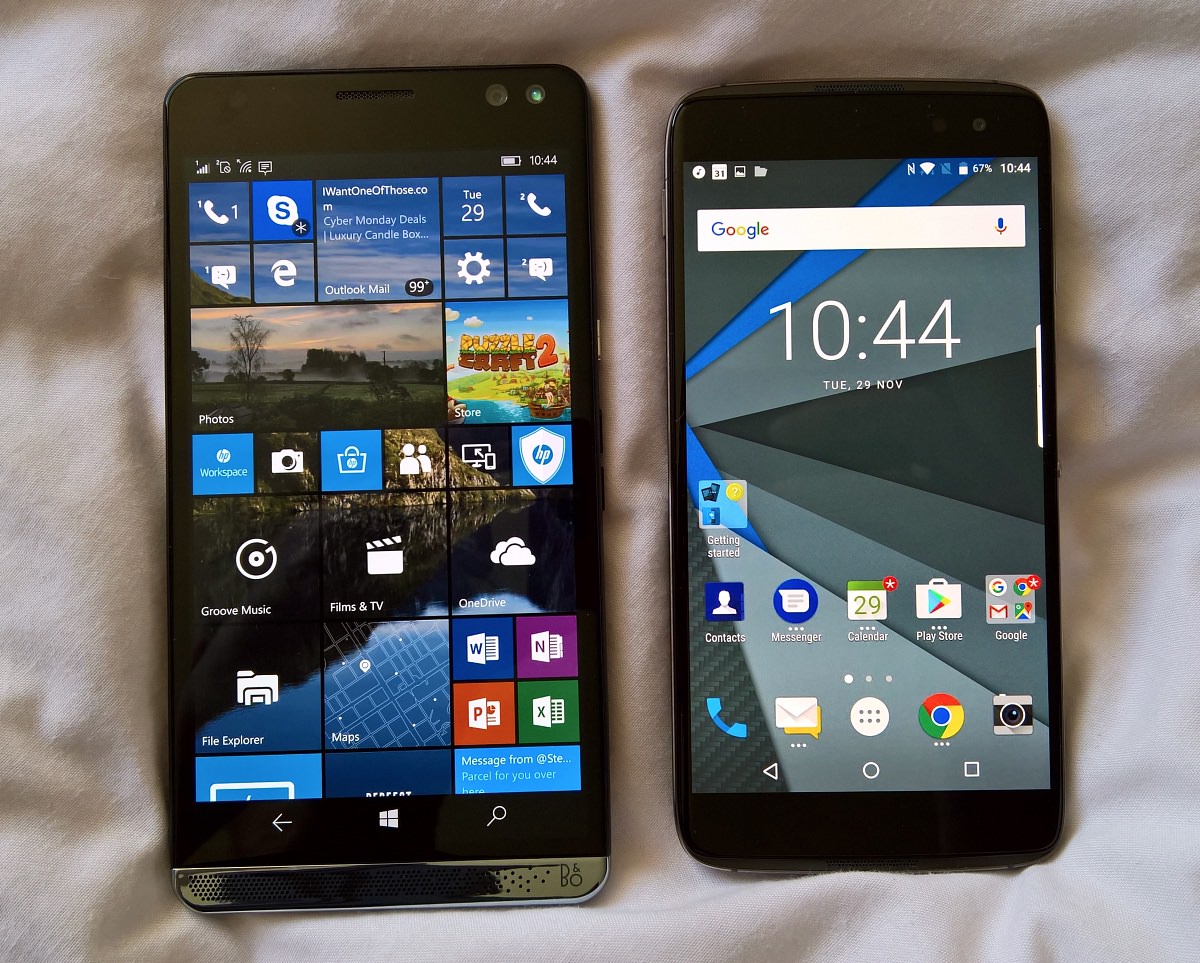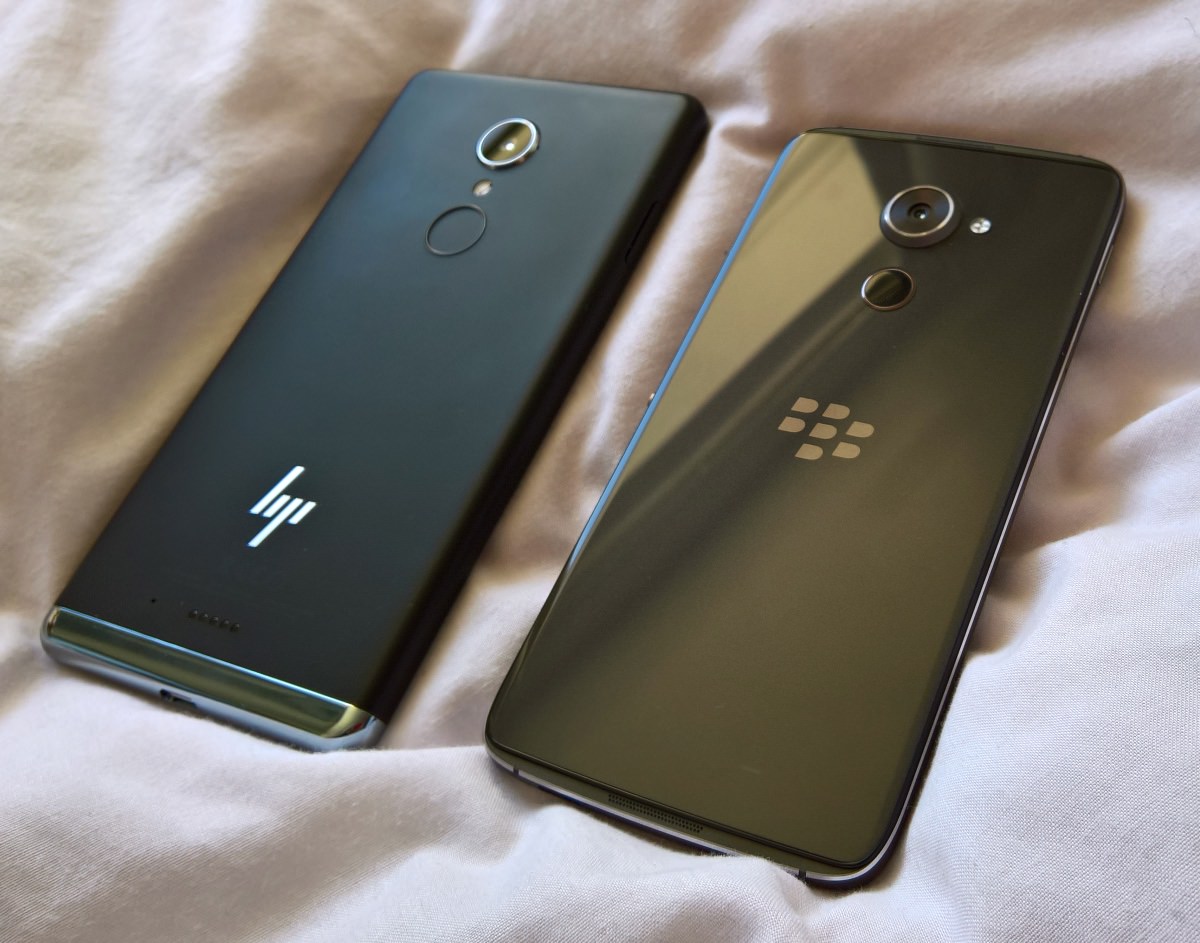
Each device, as usual, has its strengths and weaknesses. As usual, I've shaded in green an obvious 'win' for either device, I honestly have no idea which way this one's going to go (as I start to compile the feature)... Any row where a winner would be totally subjective is left uncoloured.
[By the way, if you're viewing this feature on an older Windows Phone then the table may well cause you problems. Try viewing in landscape mode? Failing that, go view this on a laptop or tablet and then roll on Windows 10 Mobile across the board on all the older phones!]
| HP Elite X3 | Blackberry DTEK60 | |
| Date first available | September 2016 | November 2016 |
| Current price, availability | £700 (SIM-free in the UK, inc VAT - from Clove - and including Continuum Desk Dock and various adapters and cables). Other prices and bundles available, including with the Lapdock, but starting at about £630 inc VAT but rising to over £1000! | £475, SIM-free, for the 128GB model from Clove - including a fast charger and case. |
| Dimensions, form factor, weight |
162 x 83 x 8mm, heavy duty plastic body and frame, 195g.
|
154 x 75 x 7mm, aluminium chassis with oleophobic glass front and back, incredibly slippery in the hand and even flat on a desk! Quite a bit shorter and slimmer (but then the screen is quite a bit smaller too), 165g |
| Durability | IP67 for liquid and dust, plus mil-spec drop and shock resistance, thanks to the use of shock-absorbing plastics rather than metal. | No quoted durability stats, so probably water-vunerable and shock-vulnerable (all that glass) so you definitely need a case all the time! |
| Operating system, interface | Windows 10 Mobile, (dismissable) virtual controls |
Android 6.0 with virtual controls, dismissable/minimised in certain applications and games. |
| Display | 5.96" AMOLED QHD (1440p), tough Gorilla Glass 4 | 5.5" QHD (1440p) resolution, AMOLED, 'scratch-resistant glass' |
| Connectivity | LTE up to 600Mbps, plus dual nano SIM (if microSD unused), NFC, Wi-Fi b/g/n/ac, integral wifi tethering, Bluetooth 4.2 (with full set of profiles and exchanges), | LTE (all bands), NFC, Bluetooth 4.2, Wi-Fi b/g/n/ac, integral wifi tethering, single nanoSIM |
| Processor, performance | Snapdragon 820 chipset, 4GB RAM, in theory very fast indeed - though there are still big optimisations to come when Redstone 2 hits in the Spring (2017). | Snapdragon 820 chipset, 4GB RAM, very fast, as Android typically is, with minimal transitions. Have to give the win here on speed. |
| Capacity | 64GB, expandable via microSD up to 2TB | 32GB, expandable via microSD to 256GB |
| Imaging (stills) |
13MP (currently, ignore what you've read about 16MP) f/2.2, single LED flash, HDR shots, PDAF in theory, but waiting on a firmware update. Decent shots in most light conditions, though ultimately limited compared to the industry leaders in the smartphone world. See here for my full Elite X3-Lumia 950 XL shootout, for example. 8MP front camera |
21MP, f/2.0 1/2.8" sensor, Phase Detection auto-focus, dual LED flash, HDR available. Current firmware is buggy and low light shots are terrible - this should improve with updates though. 8MP front camera, f/2.2 |
| Imaging (video) | 4K, digitally stabilised, with 'Best photo' 8MP grabbing built-in, plus stereo audio recording (though limited to mono in current firmware) | 4K video capture, with optional digital stabilisation - it works, but is very 'jellovision' compared to the Microsoft implementation on the X3. Audio is excellent and in stereo though - so hard to pick an overall winner here. |
| Music and Multimedia | Decent front-facing stereo speakers, though very weak in terms of bass frequencies (surprising, given the B&O branding, it's possible that there are optimisations yet to come - I'm going to nudge HP in a future piece). 3.5mm headphone jack | Decent front-facing stereo speakers, getting much better in terms of volume and EQ thanks to the included MaxxAudio EQ system. A user would have to know how to enable this, but it works brilliantly and gets much more from the physical hardware. 3.5mm headphone jack |
| Navigation | Windows 10 Maps is comprehensive, has a degree of live traffic awareness, plus public transport. Includes full offline maps with automatic updates. |
Google Maps and navigation is truly excellent, with better offline capabilities in the last year, and with great live traffic integration and dynamic re-routing (which get it the win here). Oh and there's also HERE Maps, if the user knows to go look for it. |
| Cortana/Voice | Cortana is now mature and well integrated, and with a surprising degree of 'assistance'. | Google Now and voice queries are good and on a par with Cortana overall, if not superior. See my round-up feature. A little too ready to pass things off to Google search queries, if I'm being picky, so I'm not going to pick a winner. |
| Battery, life | Sealed 4150mAh battery, gets through two days of use (even on the buggy firmware), plus standard USB Type C fast charging (up to 3A, though a 2A charger is what's supplied out of the box) and Qi wireless charging built-in. | Sealed 3000mAh battery, easily gets through a day, thanks to Android 6.0's Doze feature. USB Type C charging with Quick Charge 3.0 compatibility. Flexible and capable, but not in the Elite X3's league here. |
| Cloud aids | Windows Photos syncs across all signed-in devices, subject to your OneDrive tariff (which is tight for new users, meaning that they'll end up paying extra), should you have thousands of images in the system. Plus Windows 10 backs all your media, application data and settings to a separate backup folder system, tariff-free on OneDrive. | Google Photos syncs across all Android devices, genuinely infinite storage (with an allowance for recompression/optimisation by Google) |
| Biometrics | Iris recognition ('Windows Hello') works well unless you wear varifocals(!), but takes a few seconds in real world use, while the fingerprint sensor on the back is quicker and easier most of the time, to power the screen on and authenticate. Good to have a choice though. | Fast fingerprint scanner on the back works well too, also powering on and authenticating at the same time. |
| Applications and ecosystem | Windows 10 Mobile now has just about every mainstream app covered, aside from Snapchat and Tinder. Niche/boutique apps are often an issue, though... Also anything to do with Google services! | Fully covered, from A-Z, these days. Any application of any significance in the mobile world is available for Android. |
| Business extras | Continuum connectivity to use external displays as secondary screen, independent of the phone display (with full universal application resolution handling) - Desk Dock, Lap Dock and anything Miracast-enabled. HP Workspace commercial system for running Win32 applications when hooked up. | Blackberry Password Keeper (secure database integrated into the Blackberry keyboard). Blackberry Workspaces cloud drive access (it's not clear if this is limited). Blackberry Hub for email accounts. Plenty of thought put into the software bundle, but there's nothing in terms of hardware. |
| Upgrades and future | Windows 10 Mobile will be updated through 2017, of course, as part of the global Windows 10 ecosystem. Production devices can expect updates every few months, Insiders every few weeks. The X3 is part of the Insider program if needed. | Blackberry have a great update record and I'd expect them to pass on the Google security updates every month without fail. Plus Android 7.0 early next year. |

Verdict
Fittingly, the green 'wins' come out at 5 apiece, so after all of the above thousand words and observations, I can't pick an overall winner. Both are very competent smartphones/phablets with a number of business-related features. The DTEK60 will appeal to someone who wants the various Blackberry applications and services, perhaps following on from a Blackberry 10 device, while the HP Elite X3 will appeal (funds permitting) to someone wanting to extend the phone itself with Continuum displays and the Lap Dock, i.e. going way beyond what a mere 'phone' should be capable of by itself.
Honours even then, but your thoughts and comments are welcome.
PS. Thanks to Clove for the review loan of the DTEK60.
